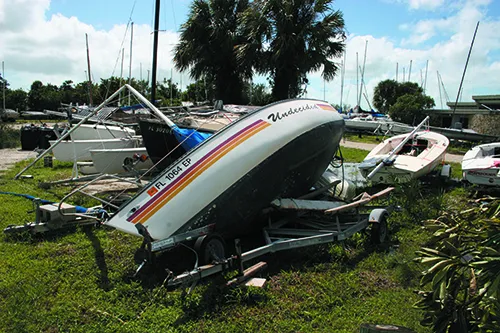
For older boats, unless it has some classic bronze, scrapping an abandoned boat for parts is probably a fool’s errand. Consignment shops are full of old worn-out parts and they’ll pay you just 60 percent of your selling price—usually about 25 percent of the part’s value when new. Not everything sells, and much sits around for years.
For our take on consignment shops, read “A Treasure Hunting Guide to Secondhand Boat Gear,” PS April 2011. As for the scrap metal, the disposal company may have been depending on the scrap value of the stainless rails, mast, and keel, and will charge more if those are gone.
If the boat must get to the disposal facility on her own bottom, that also limits what you can remove. If she must be towed, that’s another expense. Best to negotiate this ahead of time. Based on the few efforts we have seen, you should see this as a labor of love, not an effort to recover value.
Fiberglass recycling
While other countries have developed industrial recycling solutions for fiberglass waste, in the U.S., fiberglass is primarily landfill material.
Recyclers can shred the laminate for reuse as filler in non-critical applications, such as manhole covers and benches, but these recyclers are most interested in pre-consumer waste. In the case of a boat hull, the fiberglass must be laboriously separated from the non-fiberglass parts. The equipment is expensive and the outlets for recycled products are limited.
Cement kilns fuel is another alternative. The Rhode Island Marine Trades Association, with funding from Sea Grant (a NOAA program) has been operating a pilot program for five years, wherein boats are stripped of all large metal and mechanical items and shredded using construction debris recycling equipment.
The resultant 2-inch or smaller chucks are fed into a cement kiln, where they serve as fuel (wood and resin) and ingredients (iron and fiberglass) in the manufacture of Portland cement.
Unfortunately, the shredded material competes with hazardous waste and other hard-to-dispose of materials that industries are willing to pay top dollar for disposal. As a result, it costs more to take it to the kiln than to bury it in the ground.
Pyrolysis, a process in which organic materials are heated in the absence of oxygen to break molecular bonds and recover potentially valuable liquids, is another alternative. I was involved in some of these projects in the 80s; they weren’t competitive back in the oil crunch days, when inflation adjusted oil prices were higher than anything we will likely see for a generation.
We wish we could tell a better story, but the best answer at this moment is generally to remove the engine, rig, and keel, and smash the rest. Just so much more inert material buried. It came from the ground, and back it goes.

































